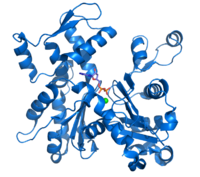
Photo from wikipedia
Selective fluorescence imaging of actin protein hugely depends on the fluorescently labeled actin-binding domain (ABD). Thus, it is always a challenging task to image the actin protein (in vivo or… Click to show full abstract
Selective fluorescence imaging of actin protein hugely depends on the fluorescently labeled actin-binding domain (ABD). Thus, it is always a challenging task to image the actin protein (in vivo or in vitro) directly with an ABD-free system. To overcome the limitations of actin imaging without an ABD, we have designed a facile and cost-effective red fluorescent coumarin dye 7-hydroxy-4-methyl-8-(4-(2-oxo-2H-chromen-3-yl)thiazol-2-ylimino)methyl-2H-chromen-2-one (CTC) for actin binding. The selective binding of the dye was investigated using the gut and eye of the model organism Drosophila melanogaster and C2C12 and SCC-9 cell lines. Our result suggests two major advantages of CTC over the dyes presently used for imaging actin proteins. First, the dye can bind to actin efficiently without any secondary intermediate. Second, it is much more stable at room temperature and exhibits excellent photostability. To the best of our knowledge, this is the first fluorescent dye that can bind to the actin protein without employing any secondary intermediate/actin-binding domain. These findings could pave the way for many biologists and physicists to successfully employ the CTC dye for imaging and tracking actin proteins by fluorescence microscopy in various in vivo and in vitro systems.
Journal Title: Bioconjugate chemistry
Year Published: 2022
Link to full text (if available)
Share on Social Media: Sign Up to like & get
recommendations!